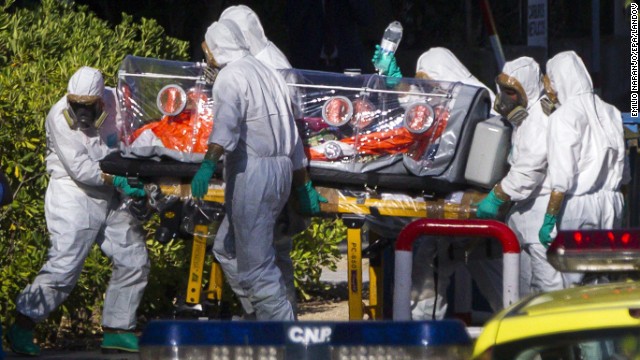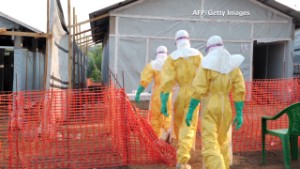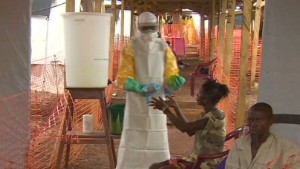A cancer cell containing the nanoparticles. The nanoparticles are
colored green, and have entered the nucleus, which is the area in blue.
Credit: M. Welland
has been successfully tested by scientists.
The ground-breaking technique could eventually be used to treat glioblastoma
multiforme, which is the most common and aggressive brain tumour in
adults, and notoriously difficult to treat. Many sufferers die within a
few months of diagnosis, and just six in every 100 patients with the
condition are alive after five years.
The research involved engineering nanostructures containing both gold
and cisplatin, a conventional chemotherapy drug. These were released
into tumour cells that had been taken from glioblastoma patients and
grown in the lab.
Once inside, these "nanospheres" were exposed to radiotherapy. This
caused the gold to release electrons which damaged the cancer cell's DNA
and its overall structure, thereby enhancing the impact of the
chemotherapy drug.
The process was so effective that 20 days later, the cell culture
showed no evidence of any revival, suggesting that the tumour cells had
been destroyed.
While further work needs to be done before the same technology can be
used to treat people with glioblastoma, the results offer a highly
promising foundation for future therapies. Importantly, the research was
carried out on cell lines derived directly from glioblastoma patients,
enabling the team to test the approach on evolving, drug-resistant
tumours.
The study was led by Mark Welland, Professor of Nanotechnology and a
Fellow of St John's College, University of Cambridge, and Dr Colin
Watts, a clinician scientist and honorary consultant neurosurgeon at the
Department of Clinical Neurosciences. Their work is reported in the
Royal Society of Chemistry journal, Nanoscale.
"The combined therapy that we have devised appears to be incredibly
effective in the live cell culture," Professor Welland said. "This is
not a cure, but it does demonstrate what nanotechnology can achieve in
fighting these aggressive cancers. By combining this strategy with
cancer cell-targeting materials, we should be able to develop a therapy
for glioblastoma and other challenging cancers in the future."
diagram showing the composition of the nanosphere. Credit: M. Welland
Used on their own, chemotherapy drugs
can cause a dip in the rate at which the tumour spreads. In many cases,
however, this is temporary, as the cell population then recovers.
"We need to be able to hit the cancer cells directly with more than
one treatment at the same time" Dr Watts said. "This is important
because some cancer cells are more resistant to one type of treatment
than another. Nanotechnology provides the opportunity to give the cancer
cells this 'double whammy' and open up new treatment options in the
future."
In an effort to beat tumours more comprehensively, scientists have
been researching ways in which gold nanoparticles might be used in
treatments for some time. Gold is a benign material which in itself
poses no threat to the patient, and the size and shape of the particles
can be controlled very accurately.
When exposed to radiotherapy, the particles emit a type of low energy
electron, known as Auger electrons, capable of damaging the diseased
cell's DNA and other intracellular molecules. This low energy emission
means that they only have an impact at short range, so they do not cause
any serious damage to healthy cells that are nearby.
In the new study, the researchers first wrapped gold nanoparticles
inside a positively charged polymer, polyethylenimine. This interacted
with proteins on the cell surface called proteoglycans which led to the
nanoparticles being ingested by the cell.
Once there, it was possible to excite it using standard radiotherapy,
which many GBM patients undergo as a matter of course. This released
the electrons to attack the cell DNA.
While gold nanospheres, without any accompanying drug, were found to
cause significant cell damage, treatment-resistant cell populations did
eventually recover several days after the radiotherapy. As a result, the
researchers then engineered a second nanostructure which was suffused
with cisplatin.
The chemotherapeutic effect of cisplatin combined with the radiosensitizing effect of gold nanoparticles
resulted in enhanced synergy enabling a more effective cellular damage.
Subsequent tests revealed that the treatment had reduced the visible
cell population by a factor of 100 thousand, compared with an untreated
cell culture, within the space of just 20 days. No population renewal
was detected.
The researchers believe that similar models could eventually be used
to treat other types of challenging cancers. First, however, the method
itself needs to be turned into an applicable treatment for GBM patients.
This process, which will be the focus of much of the group's
forthcoming research, will necessarily involve extensive trials. Further
work needs to be done, too, in determining how best to deliver the
treatment and in other areas, such as modifying the size and surface
chemistry of the nanomedicine so that the body can accommodate it
safely.
Sonali Setua, a PhD student who worked on the project, said: "It was
hugely satisfying to chase such a challenging goal and to be able to
target and destroy these aggressive cancer cells.
This finding has enormous potential to be tested in a clinical trial in
the near future and developed into a novel treatment to overcome
therapeutic resistance of glioblastoma."
Welland added that the significance of the group's results to date
was partly due to the direct collaboration between nanoscientists and
clinicians. "It made a huge difference, as by working with surgeons we
were able to ensure that the nanoscience was clinically relevant," he
said. "That optimises our chances of taking this beyond the lab stage,
and actually having a clinical impact."





 Ebola coverage: informing vs. overhyping
Ebola coverage: informing vs. overhyping Delayed response cause Ebola to spread?
Delayed response cause Ebola to spread?  Man loses 7 relatives to Ebola
Man loses 7 relatives to Ebola.jpg)